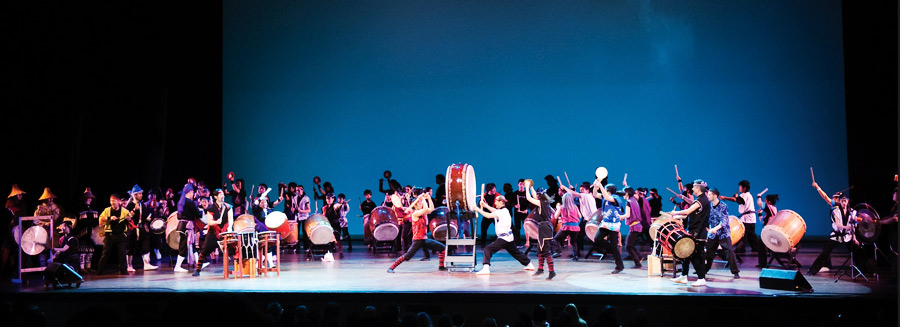On April 19, 2011, five weeks after a devastating earthquake and tsunami hit the Tohoku region of Japan, a fundraising concert, Ganbare Japan!, was held at Vancouver’s Queen Elizabeth Theatre. Presented by the BC Japan Earthquake Relief Fund (BC-JERF), the concert featured a broad range of performers from across the musical spectrum. In a special treat, Jon Kimura Parker and over forty members of the Vancouver Symphony Orchestra performed Mozart’s Piano Concerto #27 K595. Other performers included Erin Wall, David Pomeroy and Kinza Tyrrell from Vancouver Opera, dancers and singers from the Squamish Nation, Takeo Yamashiro on shakuhachi and butoh dancer Jay Hirabayashi. A who’s who of the local music and dance scene including Jim Byrnes, The Sojourners, Bill & Saffron Henderson, Mae Moore, 54-40 and Simon Kendall took the stage for the second half.
The evening concluded with an unprecedented collaboration between members of the Vancouver taiko community. Representatives from Chibi Taiko, Katari Taiko, Sawagi Taiko, LOUD, Sansho Daiko, Tetsu Taiko and Yuaikai Ryukyu Taiko along with independent taiko players Eien Hunter-Ishikawa, Bonnie Soon, Leslie Komori and Boyd Grealy joined forces for a twenty-minute taiko tour-de-force that raised the roof for the Japanese people.
The drummers were joined by Squamish dancers and drummers Spakwus Slolem, and as over 14,000 origami cranes rained down on the stage and the audience following the final drum beat, the energy in the theatre was palpable.
Taiko for Tohoku was a truly intergenerational endeavour that reflects the 32-year development of taiko in Canada. The project was driven by many of the pioneers of Canadian taiko—drummers who helped shape this unique art form in its earliest days and continue to have an impact on its development. At the other end of the spectrum, the youngest members of the collaboration represent the next generation of taiko players. Junior members of Chibi Taiko and Yuaikai Ryukyu Taiko range in age from six to their early twenties, bringing a youthful vitality and energy to what was a once-in-a-lifetime event.
Taiko for Tohoku opened with a thunderous performance by Yuaikai Ryukyu Taiko, comprised of 18 members of the Okinawan diaspora. The song, Mirukumunari, is from Kohama Island, one of the southern-most islands of Okinawa. A harvest song, it shares the joys and gratitude of community living and wishes prosperity to all.
This was followed by an excerpt of an adaptation of Utsu Hachijo, originally composed by Japan’s Ondekoza. The composition takes its name from Hachijo Island, where political prisoners were once banished. Replacing their confiscated swords with bachi (drumsticks) the prisoners drummed and sang to express their longing for their home.
The finale to the Taiko for Tohoku collaboration was based on Ashura, a piece composed by Mas Kodani of Kinnara Taiko, a Buddhist group from Los Angeles. In Buddhist teachings, Ashura is the realm of the fighting spirit and the piece draws upon conflict, both internal and external, as its driving metaphor. As the piece reached its thunderous climax, all the drummers united on stage in a show of solidarity and strength, summoning the spirit of the drum and sending a message across the ocean: “Ganbare Japan!”
The following photos were taken by Joe Kuo at the final rehearsal.
[nggallery id=1]
Taiko for Tohoku was conceptualized and coordinated by a committee made up of John Endo Greenaway, Kayo Homma-Komori, Shinobu Homma and Eileen Kage and made reality over three nights of rehearsals in a true collaboration with all the drummers involved.
The committee would like to thank all the taiko groups and independent players, along with the parents of the Junior members, for the spirit of cooperation they have shown, and their unwavering support of this project.
We would also like to thank the National Nikkei Museum & Heritage Centre for the generous use of rehearsal space, Uzume Taiko for the use of its van, and Chibi Taiko, Tetsu Taiko and Stratford Hall Taiko for the use of drums and percussion, along with everyone else who contributed instruments, ideas and energy.
A special shout-out to Linda Ohama who drove the entire Ganbare Japan! concert from the beginning with fearless optimism and spirit.

Pingback: The 2011 Vancouver Folk Festival | youth in 57 minutes